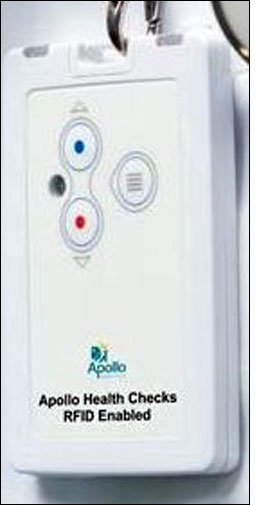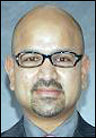Apollo Hospital Chennai, India’s largest health-care facility, is employing an Icegein real-time locating system (RTLS), with Ekahau tags, to move 250 patients a day through a series of up to 26 diagnostic procedures. The system, installed in May of this year, has enabled the hospital to improve the flow of patients through the process, and to save each patient hours of time that previously may have been spent waiting for a procedure to take place. Although it is still too early to measure all of the benefits derived from the system, the deployment is expected to not only shorten the time patients spend at the hospital, but also allow the facility to serve more patients each day, due to the added efficiency it provides.
Apollo was the first of India’s hospitals to provide a “package” consisting of all of a patient’s annual health-care diagnostic needs in a single day. Rather than undergo each procedure at a separate location and at a different time of the year, a patient can schedule a series of procedures to be held on the same day at the hospital. Once annually, each patient arrives at 7 a.m. and proceeds through as many as 26 procedures, by moving from one department to the next. Those may include blood tests, x-rays, echocardiograms, sonograms and mammograms, in order to measure the patient’s health. Since Apollo implemented the plan, other Indian health-care companies have been offering similar programs as well.

However, because of the hospital’s size, as well as the large population of the community it serves (there are 3.5 million people living in the city of Chennai alone), the number of patients is large—about 250 each day—and managing their movements throughout the many departments was a challenge. Patients were not always clear which department they should report to next, they could end up waiting unnecessarily in the wrong area, and bottlenecks were often created by too many patients in one location and not enough in another, thereby leading to delays. Although the procedures begin at 7 a.m. and should be completed by about 11 or 11:30, says Anand Surana, Icegein’s CEO, patients were often still in the hospital until 3 p.m. or later, which placed limits on the number of people who could be served during a given day.
The Icegein system consists of active RFID tags for each patient, Wi-Fi nodes to read those tags, Icegein software to interpret and manage the read data, and digital monitors to display directions to patients. The system transmits data from Ekahau 2.45 GHz RFID tags to 24 Cisco Wi-Fi nodes, which Icegein and Cisco installed throughout the diagnostics portion of the building. Information from the nodes—the tag’s ID number and its location based on the IDs of the Wi-Fi nodes receiving the transmission—is then forwarded to Icegein software known as Patient Mantra, residing on the hospital’s back-end database, which interprets location data and links that information to the existing patient-management software system that Apollo uses to manage data related to patient visits and billing.
Hospital managers signed onto the Patient Mantra system can view a map showing where each patient is located in the hospital, which procedures for each patient still need to be performed, and the number of people waiting in each area. The software can also alert the staff if a particular section is too congested, enabling managers to move patients from one location to another, or to rearrange future schedules. It also identifies the location of the ID number for each patient, and compares that data against that person’s expected location. If he or she is in the wrong area, management can be alerted and can determine how to proceed—for example, they can decide whether a staff member needs to redirect that patient to the proper station. At the same time, video screens installed at each department display every patient’s name, along with the department he or she should go to next.
When a patient registers at the hospital for services, Surana explains, he or she is given a lanyard with a 2-by-5-inch Ekahau tag containing a unique ID number, linked in the Icegein software and Apollo back-end software to the patient’s name and health-care information. At the registration desk, the patient is given a schedule of appointments, listing all of the departments he or she needs to visit, and is informed which department to visit first. The Ekahau tag has three buttons, and a staff member presses one of them in order to activate the tracking of that patient. Anywhere that individual goes within the diagnostic procedure portion of the hospital, he or she can be tracked using the Wi-Fi system. For instance, when the patient goes to the blood department, the system knows when he or she has arrived based on the tag ID reads, and can then determine that the individual is waiting there for services. If it should only take 15 minutes to be seen in that department, the Icegein software will display an alert on a PC being monitored by hospital management, indicating when a patient has been waiting for longer than the expected time span. Management can then instruct employees to redirect some patients, or to use the data to adjust future scheduling to improve traffic flow.
Once the patient is being seen for a particular service, such as a blood draw, a hospital worker presses another button on that person’s tag to indicate that the service has begun. After the service is complete, the employee presses a third button on the tag. At this point, the software displays which department the visitor should go to next. The patient’s name and the next department of service are then displayed on the digital screen mounted in every department, to help direct the patient to the correct area of the hospital. If the patient were to miss this information and proceed to the wrong department, Surana says, the software can adjust for that discrepancy, permit the service to take place (unless it was already provided to the patient on that day, or if it is not required for that patient) and the software will again instruct the patient, on the screen, to visit the next appropriate department.
The system is set up for other exceptions as well. If a patient decided to leave the hospital before completing scheduled services, the system would detect that a tag was out of range of the Wi-Fi nodes, and a computer screen would display an alert to a security guard at the exit door. The guard could then intercept that person as he or she walked through the exit, and redirect that patient to the proper location. If someone who had completed all of the procedures attempted to leave the facility without returning a tag, he or she would likewise set off an alert for the security guard, so that the guard could retrieve the tag. If a patient has an emergency during any services, he or she can simply tug down on the tag, thereby triggering an alert that is transmitted to the back-end system and displayed on the Icegein software, indicating the name and location of the patient requiring assistance.
Since the system became operational, Surana says, Apollo Hospital Chennai has been able to move patients through procedures more quickly, thus moving closer to the goal of completion before noon. In the future, he adds, Apollo intends to install the system at some of its other hospitals (of which there are currently 48 in India) for similar purposes (diagnostic processes). The Chennai facility also has future plans to install the system to track patients within its emergency department. And other hospitals are in discussions with Icegein as well, to install the system in their own buildings.


